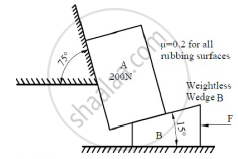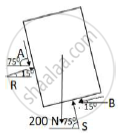Advertisements
Advertisements
Question
Find the force ‘F’ to have motion of block A impeding up the plane. Take coefficient of friction for all the surfaces in contact as 0.2. Consider the wedge B as weightless. Refer Figure 11.

Solution

Consider block A,
ΣFx = 0
-Bcos(15) – Scos(75) + Acos(75) + Rcos(15) = 0
-0.2Scos(15) – Scos(75) + 0.2Rcos(75) + Rcos(15)
S(-0.2cos(15)-cos(75)) + R(0.2cos(75)+cos(15)) =0 ……(1)
ΣFy = 0
-200 - Bsin(15) + Ssin(75) + Rsin(15) – Asin(75) = 0
-0.2Ssin(15) + Ssin(75) – 0.2Rsin(75) + Rsin(15) = 200
S(-0.2sin(15)+sin(75)) + R(sin(15)-0.2sin(75) = 200 ……(2)
Now, Solving (1) and (2),
S=212.019 N R=94.168 N

Consider block wedge B,
ΣFx = 0
-F + Scos(75) + Csin(75) + D = 0
F = Scos(75) + 0.2Ssin(75) + 0.2T
ΣFy = 0
T – Ssin(75) + Ccos(75) = 0
T = Ssin(75) – 0.2Scos(75)
T = 193.8197 N
F = Scos(75) + 0.2Ssin(75) + 0.2TN
F = 134.597 N
The magnitude of the force F is 134.597 N.
